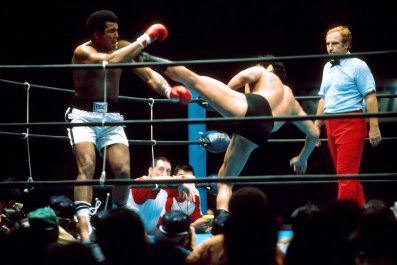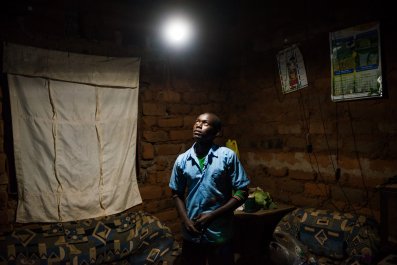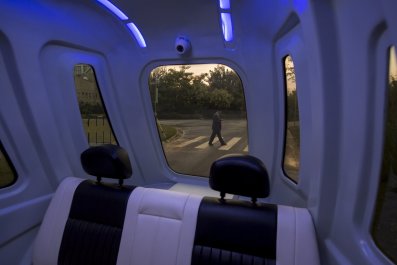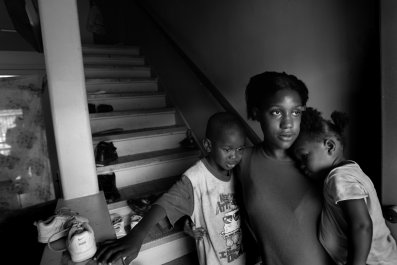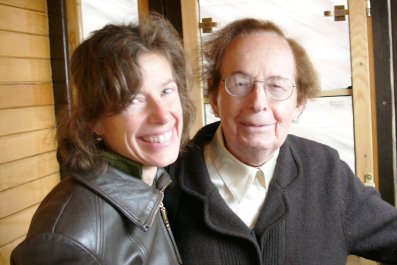When Planned Parenthood first invited me to see its virtual reality film Across the Line, I thought the focus would be on the many hurdles women face seeking reproductive health care in Mexico. The line in the title could have been the U.S.-Mexico border—Mexico has some of the strictest abortion laws in the world.
But when I don the goggles, I instead find myself inside a clinic in the United States. Off to one side—the view is 360 degrees—is Dr. Raegan McDonald-Mosley, chief medical officer of the Planned Parenthood Federation of America, comforting a visibly shaken patient named Christina who, it seems, has just walked through an anti-abortion protest outside. These are real women, not actors, re-enacting the experience of verbal harassment the organization's employees and patients routinely endure on the way to a clinic's front door.
Next, we're in the backseat of a car as Christina's friend tries to find the entrance to the center. The driver slows as she sees lines of protesters, many with detailed pleas on cardboard signs—the only word I can make out is rape, which is followed by a question mark. When Christina cracks her window to ask for directions to the health care clinic, a man tells her it's an abortion clinic and then, inching closer to the window, says, "Look, there's a place that's very safe down the street.… Let me take you there, please. Please ."
It's creepy, but this isn't the worst that the 2.5 million men and women who annually visit Planned Parenthood hear, as I see in the next scene, in which I've stepped into Christina's shoes. On the sidewalk in front of an unidentified women's health center, men and women close in on me, unleashing a stream of accusations and curses—to the left, a man calls me a wicked woman, then a tearful woman asks how I can demand my rights if I'm not willing to protect those of a child. The worst is a young man to my right who says, "Just walk in here with a smile, right? Right into a murder clinic.… God's going to destroy you in a pit of fire, and you won't be smiling then." Before I can escape, he calls me a "wicked Jezebel feminist" who "shouldn't have been a whore…sleeping with every guy at the club."
He spits his words with a ferocity that causes me—the real me—to sit straight back in my chair, tense as if ready to run or fight. He doesn't know anything about me, or Christina, or, apparently, the services performed at Planned Parenthood. Abortions accounted for a mere 3 percent of the nearly 11 million total services its clinics provided in 2013. Planned Parenthood offers STD testing and treatments; cancer screening and prevention services, like Pap tests and HPV vaccinations; and prenatal care. For many women, especially in low-income populations, these centers are the only source of family planning services and education.
Regardless of what is and isn't available at Planned Parenthood, this is just not how to act toward people, McDonald-Mosley says, and her organization made the film—and chose to make it in virtual reality—to help people see what it's like to be treated that way. "Imagine how you would be if you were in a vulnerable situation just going to see your health care provider," she says.
Artists have played on an audience's emotions to change its perspective forever, but the medium, immersive virtual reality, is new. We're still learning how VR can shape our emotions, but early research suggests that it's a more powerful storytelling tool than any we've had before for inspiring empathy and reshaping how we relate to others and ourselves.
Until recently, VR has almost exclusively been associated with video games. Some research suggests that the technology makes violent video games damagingly realistic, and the intense death and violence increases a player's risk of becoming anti-social, aggressive and less empathetic. But a 2015 study on nonviolent video games found that being immersed in a virtual world is not unlike diving into a great story—players are transported to other times and spaces feel as if they're going on a real journey, making it easier to relate to the protagonist's fate. The more players engaged with the narration in nonviolent games, the more meaningful choices and relationships they made. This suggests that in the right context, immersive VR can positively affect a person's theory of mind—the cognitive ability to take on different perspectives and assess other people's emotions, beliefs, hopes and intentions. Researchers are excited about VR's potential as a tool to help treat clinical disorders, such as autism and schizophrenia, which are thought to be connected to a lack of empathy.
Jeremy Bailenson, founder of Stanford University's Virtual Human Interaction Lab, sees virtual environments as psychological states in which individuals can perceive themselves in new ways. Along with perfecting the technology, he wants to get a greater handle on its psychological effects. His is the first lab to study the effects of VR over the long term, with approximately 1,000 people participating in a wide range of scenarios that deal with prejudice, bullying and other social ills. At his lab, researchers create and manipulate VR representations of users in an attempt to fool their brains into changing their behaviors.
In one experiment, researchers altered college students' avatars to look like their 65-year-old future selves and found those students were willing to put away twice as much money in savings than those whose avatars were unchanged. Bailenson told PBS NewsHour the visceral experience of seeing yourself older as opposed to just thinking how one day that will be true creates a "deep connection to your future self." If VR can build that kind of connection in other cases, it could be a powerful tool.
Technically, social psychologists have been creating virtual environments for decades using hard scenery, props and real people. This work can be laborious, and it's limited by real-world constraints and ethical considerations for actors. Today, computers have cleared away many of these obstacles. "Digital object models need only be created once," according to one of Bailenson's studies. But this technology is more than convenient—it has a stronger emotional effect than traditional and 3-D movies.
In 2014, a pilot study found that, when compared with a regular computer screen, VR allows for an unprecedented sense of immersion and arousal in response to certain images. A virtual spider looks much more real than a photo, and a viewer's response tends to be more realistic as well. That's a bet other filmmakers are making with hopes of increasing empathy for life in a refugee camp and life with autism.
VR is so new that there are not yet any strong studies that look at its long-term effects. Bailenson does have a short-term measure to assess VR's effect on users on their way out of the lab: After scenarios designed to increase sympathy for environmental protection, he will knock over a glass of water and take note of how many paper towels participants use to clean up the spill. But once users are out in the real world, it's anyone's guess how well they sustain what they've learned through their avatars.
Molly Eagan, Across the Line's producer, says that VR will help Planned Parenthood get viewers to experience, in a very concrete way, how bad it's gotten for patients and providers at their clinics. In 2015, a first-of-its-kind survey from the Feminist Majority Foundation revealed that since 2010, the percentage of clinics facing harassment increased from 27 to 52 percent. Confrontational posters with things like "Killers among us" on them have also proliferated. And last November, Robert Lewis Dear opened fire on Planned Parenthood's Colorado Springs, Colorado, clinic, killing a police officer and two civilians, and injuring nine others.
"What I'm hoping people do when they see this film is realize this is not how we want to treat people in this society, especially more marginalized members," McDonald-Mosley says, noting that one in three women in America will have an abortion, and those women are more likely to be women of color and low-income. "People deserve to be treated with dignity and respect." In VR and in real life.





